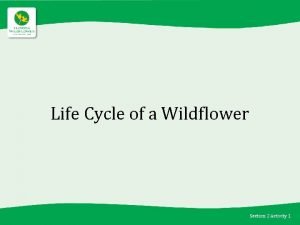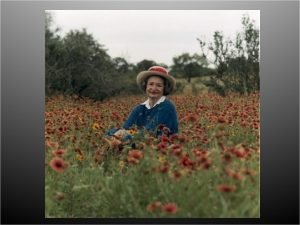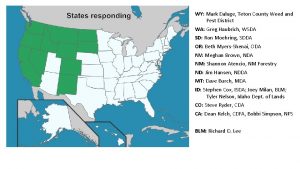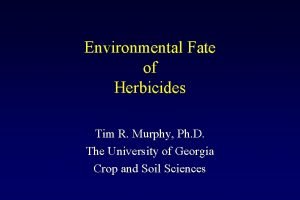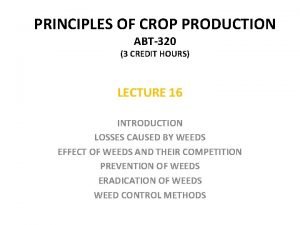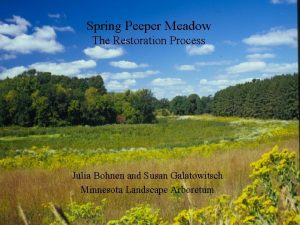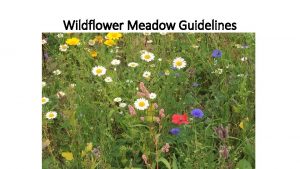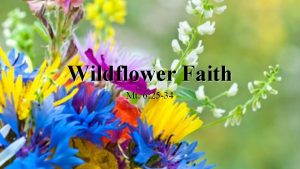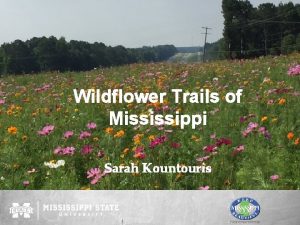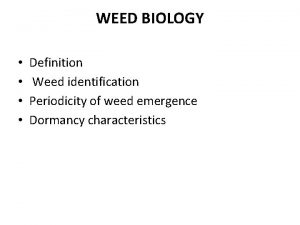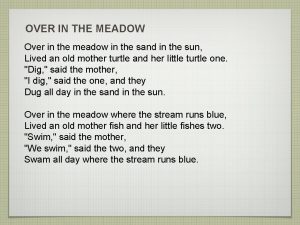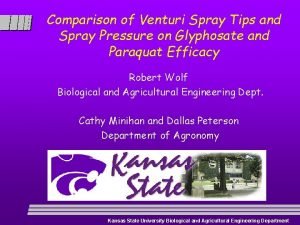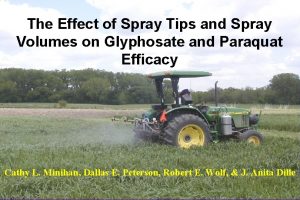Wildflower Meadow Guidelines Weed Control Spray off any














- Slides: 14

Wildflower Meadow Guidelines

Weed Control • Spray off any grass, nettles or perennial weeds in March/April when green and growing actively. • I use Roundup @ about 4 L/Ha or use a similar herbicide. • 50 mls/4. 5 L of water in a knapsack.

Cultivating • Cultivate 2 weeks after spraying, if conditions are suitable. • A fine firm fluffy dry seedbed is essential for good establishment. • Aim to sow in April if the weather is good.

Sowing Rate • Sowing rate 6 kgs per acre. • 150 gms/100 square metres. • Mix the seed with some dry sand so that you get a more even spread and don’t lose it all together.

Broadcasting • Sowing options such as broadcasting or seed drills all work but the ground must be cultivated first and the seed should be covered with a very light cultivating or raking after sowing.

Covering the seed • A very light covering is all that is required using for example a grass harrow. • A simple home-made device such as this old ESB pole pulled behind a tractor is ideal for covering the seed. • Be very careful not to bury the seed too deep. 10 mm is ample. • Rolling is not necessary.

Fertiliser • Absolutely No fertiliser because this will only encourage competition from grass and other weed. • Wildflowers do best in poor soil and this is why you often see poppies on roadside banks.

In Full Bloom • After 7 or 8 weeks you will the first flowers and after 12 you should have this result. • This will attract hundreds of bees, hoverflies and butterflies all summer. • The blue cornflower will continue flowering well into November.

Maintenance • Do nothing until the following spring because the dead flower seeds like these will attract hundreds of finches all winter and what seeds they don’t get will fall to the ground and germinate the following year. • In March cut all the dead flowers and stalks back to almost ground level and remove them.

Lightly Cultivate • After removing the trash and when the weather is good in March/April give half of the plot a very light cultivating to a depth of just 1 cm to freshen up the ground and to mix the fallen seeds with the soil. This will help them to germinate. • Leave the other half and do this the following year. The red campion will be first to flower in the spring.

Remove Weeds • If any perennial weeds such Docks, Nettles or Thistles appear just remove them by spot spraying with a knapsack or by digging them. • The same applies to grass although this will be more difficult to get rid of. Too much grass will eventually smother the flowers.

Red Flowers • You might find that the reds like the clover take over in later years so just remove some of them if you don’t like too much red and keep up the light cultivations every other year. • If you find you are losing some flowers just add another bit of seed during the cultivations.

Bright Seeds Team • Training day in Salisbury. • A full day’s training for all agents and staff is provided every year by Bright Seeds. • A presentation of new crops and an exchange of new ideas are brought to the table. • Existing crops are discussed and comparisons made from different areas.

John Howard • Irish Agent for UK based Bright Seeds. • www. brightseeds. co. uk • Attends training days regularly with Bright Seeds in Salisbury. • Over 10 years experience in trialling and experimenting with wildlife friendly crops to suit Irish schemes and conditions. • Ex fruit farmer with a keen interest in shooting and conservation. • www. rathcormacgunclub. com • e-mail; sunnysidefruit@eircom. net • Phone; 025 36253.
 Life cycle of a wildflower
Life cycle of a wildflower Florida wildflower foundation
Florida wildflower foundation Commercial pest control teton county
Commercial pest control teton county Weed control murphy
Weed control murphy Corn weed blocker
Corn weed blocker Biological method of weed control
Biological method of weed control Fuller meadow
Fuller meadow Julia bohnen
Julia bohnen A windstorm blows in hundreds of seeds from a nearby meadow
A windstorm blows in hundreds of seeds from a nearby meadow Cinderella jump rope song
Cinderella jump rope song Rectory meadow surgery
Rectory meadow surgery Cardiopathie de meadows
Cardiopathie de meadows I am a mountain at night meadow at day
I am a mountain at night meadow at day Uralic
Uralic Memory jungle
Memory jungle
